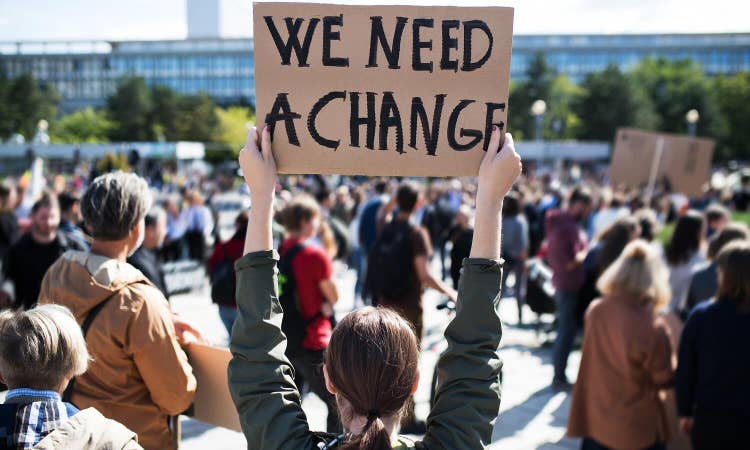

Insights
Please Reboot, Part 3: It's Time to Organize Around People
Stephen Coller, Chief Solutions Officer at UST | 7 Dec, 2020
Shared consciousness is a carefully maintained set of centralized forums for bringing people together. Empowered execution is a radically decentralized system for pushing authority out to the edges of the organization. Together…they are the beating heart of transformation.
Stephen Coller, Chief Solutions Officer at UST
The Zeitgeist is shifting. The problems we confront are too deeply ingrained for tweaks. They will not be addressed by regulating police, allocating another $1bn to support community renewal, promoting under-represented minorities, or making masks and contact tracing mandatory for warehouse workers.
As Jon Stewart said recently during an interview with The New York Times, the police now represent a border patrol between the haves and have-nots in our society. The consequences of inadequate homeless shelters, healthcare coverage, and local support don’t go away by dialing 911. Change on the scale our nation now warrants requires every organization benefiting from the existing system (which is all of us) to look inward; to identify and implement real, systematic changes that advance the interests of working people - employees, and customers both - by putting more power back in their own hands. An empowerment of this degree means changes to our business architectures, and, by default, to the platforms enabling them. It means decentralizing decision making, improving local access to resources (particularly capital and data), and organizing people for higher purposes than generating returns for the 1%.
As we have argued throughout our series of Reboot posts, we believe that our future will increasingly depend on the ability of people and organizations to create their own value networks, rather than operate at the behest of someone else’s.
As Retired United States Army General Stanley McChrystal and his team argue so eloquently in Team of Teams: New Rules of Engagement for a Complex World, to thrive in a world of networks, you have to become one yourself. A change like this requires dramatic cultural and structural transformation that does not end until management has demonstrated that it can stop acting top-down and let go of the reins, an approach McChrystal calls “Eyes on – hands off.” He reminds his reader more than once, it is not about one person. Team of Teams’ summary recommendation is this: to build a network-centric organization, invest in enabling shared consciousness and empowered execution. General McChrystal explains:
This is about pushing power back into the hands of people, be they employees, customers, investigative journalists, care-workers, creative artists, supply chain partners, community leaders, or ordinary citizens. The combinatorial effect of our mechanistic approaches to global value chains, one-click consumerism and “free speech” is to atomize and divide us from each other. Our advertising-driven, launch-test-learn journey toward commodification and uniformity has reduced us to a sum of ones and zeros rather than raised us to a sense of shared purpose and community. There are so many reasons why we would want to build a braver, better path forward. Particularly now that we have been confronted with the outrageous cost of doing otherwise.

THE MOST EFFICIENT WAY TO ORGANIZE DATA IS AROUND PEOPLE
In order to raise each other up and level the digital playing field for everyone, we must aim for technologies and architectures that enable what Majorie Kelly of The Democracy Collaborative calls a “generative effect...one that is designed to generate the conditions for life to thrive, an economy with a built-in tendency to be socially fair and ecologically sustainable”
Contrary to what the greatly missed essayist Christopher Hitchens once referred to as the “transcendentally awful” writer Ayn Rand and her acolytes, we don’t need more technology-enabled selfishness.1 What we do need is access to a platform that allows us to connect on our own terms, share data, coordinate our activities, and assure each other that we achieved our goals in a sustainable manner. As citizens in a platform-based economy, we must be assured access to technology that lets us acquire a higher level of social purpose and economic agency.
THE SHIFT FROM CORPORATIONS TO DIGITAL ECOSYSTEMS IS ALREADY UNDERWAY.
We are coming up on thirty years since the launch of the Mosaic browser, and almost fifty since the standardization of EDI. We have always been the function of an ecosystem. Our unnecessary costs, inefficiencies and frictions, and command and control governance are perpetuated by the siloed thinking and proprietary attitudes that have influenced most modern enterprise architecture.
During this time, three architectural themes have remained constant and therefore can serve to guide the business and system reformation we now require:
- centralization represents a barrier to innovation and progress
- stand-alone approaches to meeting related sets of needs are doomed to fail, and
- networks continue to respond faster than individual corporations
The inference I draw from Marjorie Kelly’s remark is that generative effects ought to be a necessary goal of any digital commerce platform. Unfortunately for enterprise architectures and platforms, generative effects can accrue only as a result of a more decentralized and networked approach to business organization and platform design. That’s it. Mathematically, and therefore computationally, there is no mechanistic system you could assemble that could compete with an ecosystem in terms of its resilience and value creation potential. Just ask Mark Zuckerberg, Jeff Bezos, General McChrystal, or David Reed.
If you accept the inference I draw from Kelly’s statement and her broader work, as well as complementary conclusions coming out of Sandy Pentland and MIT’s work on connection science and social physics, or work emanating from GMU’s recently launched Center for Resilient and Sustainable Communities, then you may also accept the notion that organizing solely for the purpose of profit is the worst thing any company could do. Not now. Not given how far our understanding has come of how sustainable systems and communities persist and grow.
From a synthesis of these inputs, you will find yourself reaching the same conclusion that we have, which is: to enable economic agency in any population, you need mutual technology serving a mutual benefit.2
How many corporations can we count on to make the switch to a more sustainable and measurable purpose? What digital solutions exist to enable their transformation? And, what would motivate their leadership and shareholders to do so?
CHANGE OR BE CHANGED
As we exit from this pandemic, business leaders will be deciding where to invest along a spectrum from enterprise to network. Between the horns of this dilemma, we see three types of commercial digital ecosystem emerging:
- Cooperatives and Credit Unions: Organizations that already enjoy the trust and loyalty of a membership in the service of a greater good but have yet to “future-proof” this invaluable market advantage using digital architecture, e.g. BECU, the Associated Press, La Caixa, Nationwide Building Society, or Costco.
- Branded or Purpose Ecosystems: Organizations including B-Corporations and NGOs that have committed publicly to goals which they cannot measure or achieve without radically greater coordination with their network partners, and, ultimately, their customers, e.g., the World Bank, leading ESG and Sovereign Wealth Funds, IKEA, Alphega, the Ford and Gates Foundations, Microsoft, or Virgin.
- Incumbents in which people report to more than one boss: Commercial organizations that are sitting on billions of dollars of intrinsic value that they will never be able to fully realize using reporting matrices, and fill-in-the-blank design initiatives. For example, J&J, 3M, Raytheon, Bank of America, or any one of the “Big 4” professional services firms.
As I write this, I can hear the protests taking place in downtown Seattle: the anger and hunger for change that our fellow citizens are expressing is audible and it is visceral. Over in a district called Capitol Hill, residents have taken over six city blocks and turned them into an impromptu public commons to debate and process what is happening to people here. They didn’t ask for permission. They simply laid claim to the resources they needed, and self-organized. That is agency at work. Now imagine if they wanted to support each other with goods and services.
My children are protesting there with their mum. I’m on my way to join them now. The four of us are determined to be the change we seek. We believe many of you are too. We hope you will be a part of our journey to a better tomorrow and commit to building a technology we can all benefit from, rather than a fortunate few. Don’t organize around the C-Suite, organize around the people. Can we at least agree to start there?
“There’s likely a place in paradise for people who tried hard, but what really matters is succeeding. If that requires you to change, that’s your mission.”
This was Part 3 of the Reboot Series. Read Part 1 here. Read Part 2 here.
With that my earlier co-author Trent Mayberry, and I will now be forking the discussion. Trent will focus on what companies can do over the next six to twelve months to reset their existing transformation plans for higher returns and digital ecosystem readiness, while I will start to describe in greater depth the platform we are building to enable those ecosystems to function.
We intend these articles to accelerate work on at least one real-world digital ecosystem. We hope that we have achieved that objective and that you will find our framing useful for your own pursuit of this goal. We look forward to comparing results.
- For an equally acute and more contemporaneous reaction to Ms. Rand’s work, read Whittaker Chambers ‘Big Sister is Watching You’, which was first published in the December 1957 edition of the National Review.
- Think of a distributed version of M-Pesa, or a distributed combination of Twitter and Square operating in a feedback loop encompassing all system participants. If you are dismissing this as science fiction you will miss the train leaving the station, because the architecture and technology to enable greater economic agency and network resilience is available now.